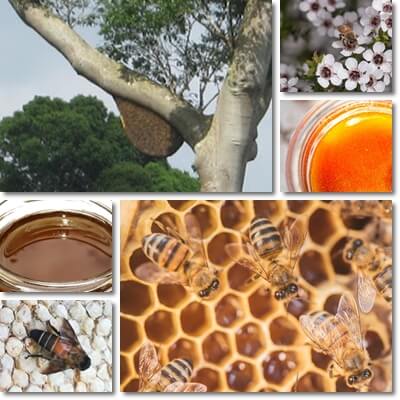Both Tualang and Manuka honey are medicinal honeys with scientifically proven therapeutic benefits. Studies show both varieties have significant antibacterial action against Gram-positive and Gram-negative bacteria, as well as wound healing effects owed to both peroxide and non-peroxide agents and a range of antioxidant phenolics. Moreover, the two honey varieties are currently being investigated for their tissue regeneration potential and considered for use as biological wound dressings for faster wound healing. But which is better between Tualang and Manuka honey?
Antibacterial activity
The biggest benefit of both Tualang honey and Manuka honey is their antibacterial activity. Both varieties exhibit bactericidal effects, that is, they destroys pathogens such as Gram-negative and Gram-positive bacteria, and bacteriostatic effects, actively inhibiting bacteria growth. The antibacterial action of both Tualang and Manuka honey is owed to the following:

- an acidic pH which inhibits bacteria multiplication
- a high sugar content which makes the honeys deposit as a protective film over surfaces and prevent further infection
- highly biologically active natural antimicrobial agents of the peroxidase type (e.g. hydrogen peroxide and gluconic acid in Tualang honey), non-peroxidase type (e.g. Methylglyoxal in Manuka honey), and non peroxidase antibacterial compounds such as phenolic acids, flavonoids, and lysozymes.
While the antibacterial activity is overall comparable, the difference is Tualang honey appears to be more effective against Gram-negative bacteria while Manuka honey is more effective against Gram-positive bacteria (study 1). However, it is important to note that Tualang honey is not just one honey, identical across years, seasons, batches etc. and can differ substantially in its antibacterial activity and other therapeutic properties according to the nectar sources. Find out more about what is Tualang honey.

Benefits for tissue regeneration
Studies on the benefits of Manuka honey for tissue regeneration show glyoxal (GO) and Methylglyoxal (MGO) occurring naturally in Manuka honey can enhance wound healing and tissue regeneration via an immunomodulatory action and inhibition of bacteria growth (study 2). Glyoxal and Methylglyoxal are non-peroxidase agents unique to Manuka honey.
Tualang honey also contains highly bioactive immunomodulatory agents such as antioxidants, various phenolics, not to mention an incredible variety of pollen sources (dozens to hundreds of pollen sources per honey), as well as peroxidase antibacterial agents such as gluconic acid and hydrogen peroxide which carry out potent tissue regeneration and wound healing effects. Studies show Tualang honey also contains non-peroxide antibacterial agents (study 3), similar to Manuka honey.
And according to research, Tualang honey may very well produce superior healing benefits. For one, Tualang honey exhibits a greater ability to heal various types and depths of wounds, better than that of conventional wound treatments. Not just this, but Tualang honey is more effective than Manuka honey against some gram-negative bacterial strains in burn wounds (study 1). Moreover, Tualang honey has a higher phenolic content and greater radical scavenging activity compared with other honey sources, which is a testament to its superior therapeutic potential.
Benefits for wound healing
Tualang and Manuka honey impregnated dressings are currently being investigated as an effective alternative to conventional hydrofibre and silver dressings for wound healing. Honey soothes pain generated by the wound in addition to promoting tissue regeneration. What makes both Tualang and Manuka honey good for wound healing are the following:
- honey acidity which increases the release of oxygen from hemoglobin and makes the wound a less favorable environment for the activity of destructive proteases.
- high osmolarity which creates an outflow of lymph by drawing out fluid from the wound.
- broad-spectrum antibacterial activity owed to peroxide and non-peroxide antibacterial agents (study 4).
- tissue regenerative effects owed to the antibacterial activity of both peroxide and non-peroxide components.
- tissue regenerative effects owed to immune system modulating pollen and various phenolic compounds.
But which is better for wound healing: Tualang or Manuka honey? Studies show the wound healing effects observed in Tualang honey-impregnated dressings are comparable to those obtained with modern hydrofibre and silver dressings (study 1). Moreover, it has been shown that wounds treated with Tualang honey show a reduction in wound size of 32.26% compared to wounds treated with conventional hydrofibre silvertreated (study 5).
Not to mention Tualang honey has a greater content of phenolics and flavonoids with benefits for tissue regeneration, and contains both peroxidase and non-peroxidase compounds with antibacterial activities in addition to a greater variety of pollen sources compared to Manuka. Given its superior biological activities, preliminary research appears to suggest Tualang honey may potentially be a better solution for faster wound healing.
At the same time, Manuka honey is relatively standardized (find out more about Manuka honey grading explained), whereas Tualang honey exhibits extensive variation in bioactive components which entails a significant variation in its wound healing effects.
Anti-ulcer action
What greatly contributes to the wound healing benefits of both Tualang and Manuka honey is their anti-ulcer action.
Ulcers are lesions in skin or mucous membranes caused by inflammation and accompanied by formation of pus and destruction of surrounding tissue. A characteristic of ulcers is slower healing time compared to other types of wounds.
Studies show Manuka honey-impregnated dressings represent an effective treatment for neuropathic diabetic foot ulcers, leading to a significant reduction in the time of healing and rapid disinfection of ulcers (study 6).
Studies also show Tualang honey is as effective as Manuka honey in the treatment of diabetic foot (study 7).
Manuka honey is also known for its benefits for gastric ulcers and gastritis, helping soothe stomach upset, reduce inflammation and promote and hurry healing of the affected gastric mucosa. Taking one tablespoon on an empty stomach in the morning, ideally after a tablespoon of pure Aloe vera gel, can help improve gastritis symptoms and even get rid of gastritis.
